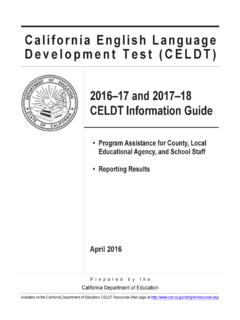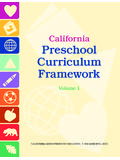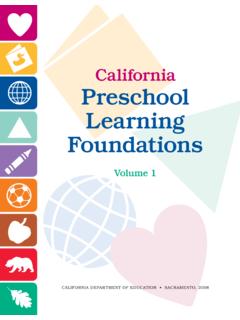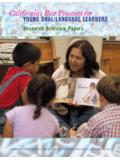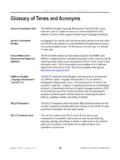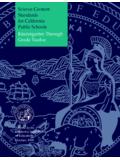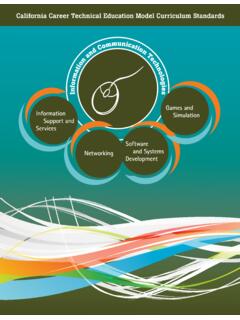Transcription of DRDP (2015) Preschool - cde.ca.gov
1 A Developmental Continuum from Early Infancy tDRDP (2015)o Kindergarten EntryPreschool Viewfor use with Preschool -age childrenCalifornia Department of EducationSacramento, 2015 The DRDP (2015) was developed by the California Department of Education, Early Education and Support Division and Special Education Division, with assistance from:Berkeley Evaluation and Assessment Research Center, University of California, BerkeleyDesired Results Access Project, Napa County Office of EducationDesired Results Developmental Profiles (2015) Instrument and Research Studies Project, WestEd s Center for Child and Family StudiesDesired Results Training and Technical Assistance Project, WestEd s Center for Child and Family StudiesThe DRDP (2015) is available at the California Department of Education Website at more informationEarly Education and Support Division Programs may contact:Desired Results Training and Technical Assistance ProjectWebsite: Email: (800) 770-6339 Special Education Division Programs may contact:Desired Results Access ProjectWebsite: : (800) 673-9220 2013-2015 by the California Department of EducationAll Rights Reserved.
2 Permission to reproduce only for instructional (2015)A Developmental Continuum from Early Infancy to Kindergarten EntryPreschool ViewFor use with Preschool -age childrenTable of ContentsIntroduction ..Intro-2 About the Measures of the DRDP (2015) ..Intro-3 The 3 Steps to Completing the DRDP (2015) ..Intro-6 Information Page (For Use with Early Education Programs) .. Intro-10 Information Page (For Use with Early Intervention and Early Childhood Special Education Programs) .. Intro-11 Quick Guide to Rating the Measures .. Intro-12 DRDP (2015) Rating Record .. Intro-13 DRDP (2015) Measures at-a-Glance .. Intro-15 Measures of the DRDP (2015) ..1-56 Glossary .. 57 Appendix .. 58 DRDP (2015): A Developmental Continuum from Early Infancy to Kindergarten Entry Preschool View August 1, 2015 2013-2015 California Department of Education All rights reserved Intro-1 of 16 Introduction to the DRDP (2015)Welcome to the Desired Results Developmental Profile (2015) [DRDP (2015)]: A Developmental Continuum from Early Infancy to Kindergarten Entry.
3 The DRDP (2015) is a formative assessment instrument developed by the California Department of Education for young children and their families to be used to inform instruction and program DRDP (2015) is based on the previous DRDP instruments. It includes refinements made over the past several years and new elements that are essential to quality early childhood education. It aligns with the California Department of Education s Early Learning and Development Features of the DRDP (2015):t The DRDP (2015) is administered in natural settings through teacher observations, family observations, and examples of children s work. Ongoing documentation of children s knowledge and skills in everyday environments is a recommended practice for early childhood The DRDP (2015) replaces the DRDP-Infant/Toddler (2010), the DRDP- Preschool (2010), and the DRDP access assessment The DRDP(2015) represents a full continuum of development from early infancy VQ UP kindergarten entry.
4 It has two views: the Infant/Toddler view for use with children in infant/toddler programs, and the Preschool View, for children in Preschool The DRDP (2015) is designed for use with all children from early infancy up to kindergarten entry, including children with Individualized Family Service Plans (IFSPs) and Individualized Education Programs (IEPs). t The DRDP (2015) is aligned with all volumes of the California s Infant/Toddler and Preschool Learning and Development Foundations, the Common Core Standards, and the Head Start Child Development and Early Learning The DRDP (2015) takes into consideration the specific cultural and linguistic characteristics of California s diverse population of young children, with specific consideration for children who are young dual language learners (see section below). t The DRDP (2015) was developed with the goal of ensuring that all children have the opportunity to demonstrate their knowledge and skills.
5 To enable access to the assessment for diverse populations, the principles of Universal Design were The DRDP (2015) includes domains that meet the federal Office of Special Education Programs (OSEP) child outcome reporting requirements for children with Individualized Family Service Plans (IFSPs) or Individualized Education Programs (IEPs).DRDP (2015): A Developmental Continuum from Early Infancy to Kindergarten Entry Preschool View August 1, 2015 2013-2015 California Department of Education All rights reserved Information about Selected Key FeaturesThree of these key features: (1) consideration of young children who are dual language learners, (2) universal design and adaptations for children with IFSPs and IEPs, and (3) a detailed description of the developmental domains that make up the instrument, are described in more detail to help teachers and service providers better understand and rate the measures of the DRDP (2015).
6 Young Dual Language Learners and the DRDP (2015)Dual language learners are children learning two or more languages at the same time, as well as those children learning a second language while continuing to develop their first (or home) language. A child s experience with one or more languages is an asset to build on in the early childhood setting. It is critical to consider the child s communication in all the languages that he or she is learning in order to have an accurate picture of a child s knowledge and skills. Young children, including children with disabilities, can successfully learn two or more languages. Learning two or more languages has linguistic, social, cognitive, academic, and cultural benefits. The path to learning one language shares many similarities with the path to learning two or more languages. There are also differences that must be taken into consideration when assessing young children who are dual language learners.
7 Children may have vocabulary for concepts in one language and vocabulary for other concepts in another language. So it is important to assess children in all of the languages he or she understands and uses. The DRDP (2015) addresses cultural and linguistic responsiveness in two primary and service providers observe and document children s behavior in both the home language and English to obtain a more accurate profile of the children s knowledge and skills across developmental and service providers rate children s progress on two language development domains. The Language and Literacy Development (LLD) domain assesses all children s progress in developing foundational language and literacy skills where ratings should be based on skills in all languages. The English-Language Development (ELD) domain assesses current knowledge and skills and progress in learning to communicate in Design and the DRDP (2015) In the context of assessment, Universal Design refers to the development of assessments that are appropriate for all children to the greatest extent possible.
8 Universal Design allows children the opportunity to demonstrate their knowledge and skills in a variety of ways. All young children are entitled access to, and meaningful participation in, age-appropriate, individually-appropriate and culturally-appropriate early childhood curricula and assessments. Teachers and service providers support children s access and participation by identifying and providing learning opportunities, materials, and teaching strategies in flexible and individualized ways and through a variety of learning modalities. DRDP (2015) assessors apply universal design when they carefully consider the various ways young children can demonstrate knowledge or skills that reflect mastery of a developmental level. Intro-2 of 16 DRDP (2015): A Developmental Continuum from Early Infancy to Kindergarten Entry Preschool View August 1, 2015 2013-2015 California Department of Education All rights reserved Intro-3 of 16 The Eight Domains of the DRDP (2015)The DRDP (2015) is made up of eight domains.
9 The focus of each domain is on the acquisition of knowledge, skills, or behaviors that reflect each domain s developmental to Learning Self-Regulation (ATL-REG)The ATL-REG domain assesses two related areas that are recognized as important for young children s school readiness and success: Approaches to Learning and Self-Regulation. These areas have been combined into one domain because of the strong connections between them. The Approaches to Learning skills include attention maintenance, engagement and persistence, and curiosity and initiative. The Self-Regulation skills include self-comforting, self-control of feelings and behavior, imitation, and shared use of space and materials. Social and Emotional Development (SED)The SED domain assesses children s developing abilities to understand and interact with others and to form positive relationships with nurturing adults and their peers. The knowledge or skill areas in this domain include identity of self in relation to others, social and emotional understanding, relationships and social interactions with familiar adults, relationships and interactions with peers, and symbolic and sociodramatic play.
10 Language and Literacy Development (LLD)The LLD domain assesses the progress of all children in developing foundational language and literacy skills. These skills can be demonstrated in any language and in any mode of communication. Language and literacy skills in a child s first language form the foundation for learning English. Therefore, dual language learners may demonstrate knowledge and skills in their home language, in English, or in both languages. LLD measures should be completed for all infants, toddlers, and Preschool -age children, including those who are dual language learners. English-Language Development (ELD)The ELD domain assesses the progress of children who are dual language learners in learning to communicate in English. The developmental progression described in the four ELD measures is related to the child s experiences with English, not the child s age. Keep in mind that children acquire English in different ways and at different rates.
